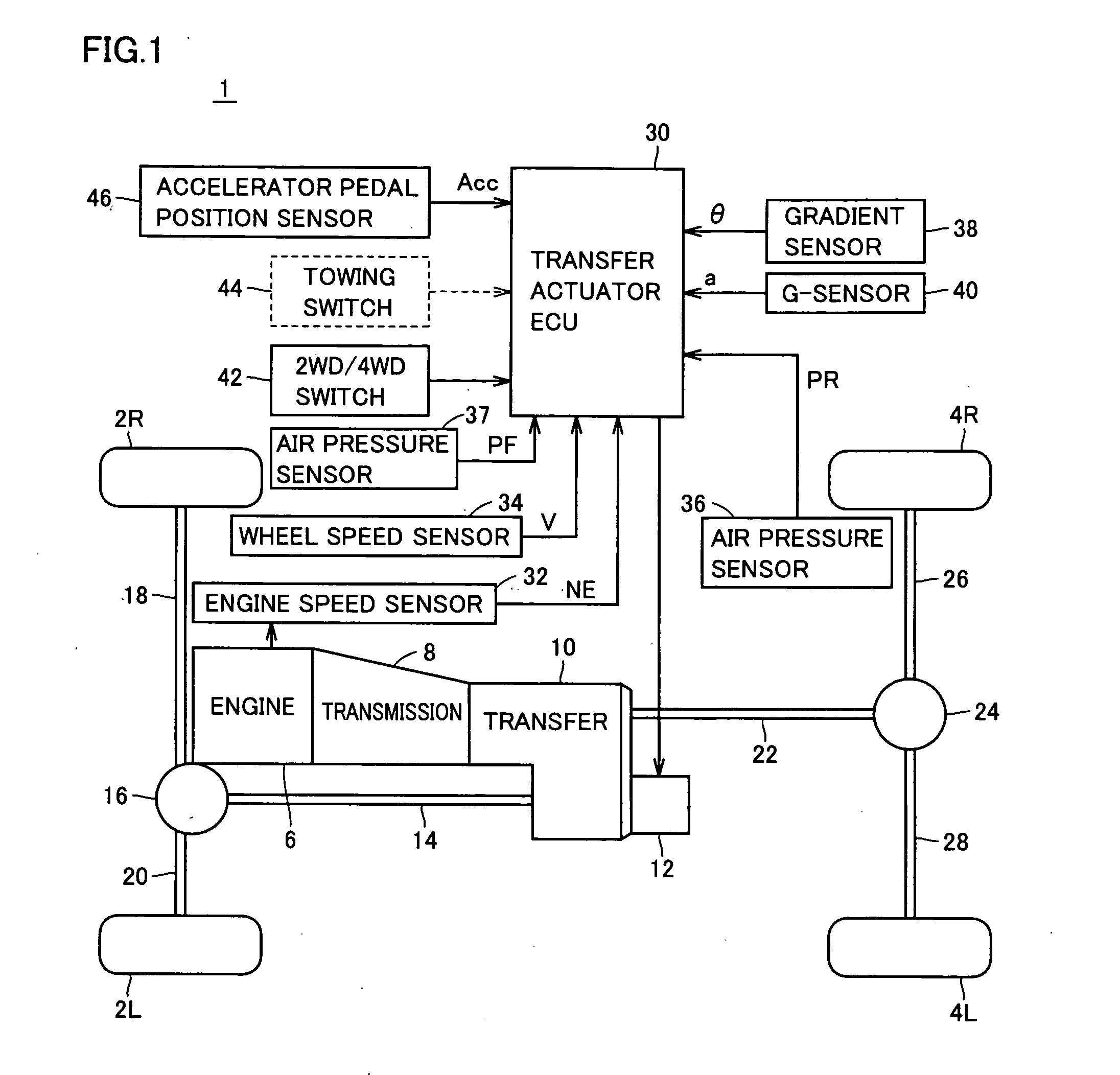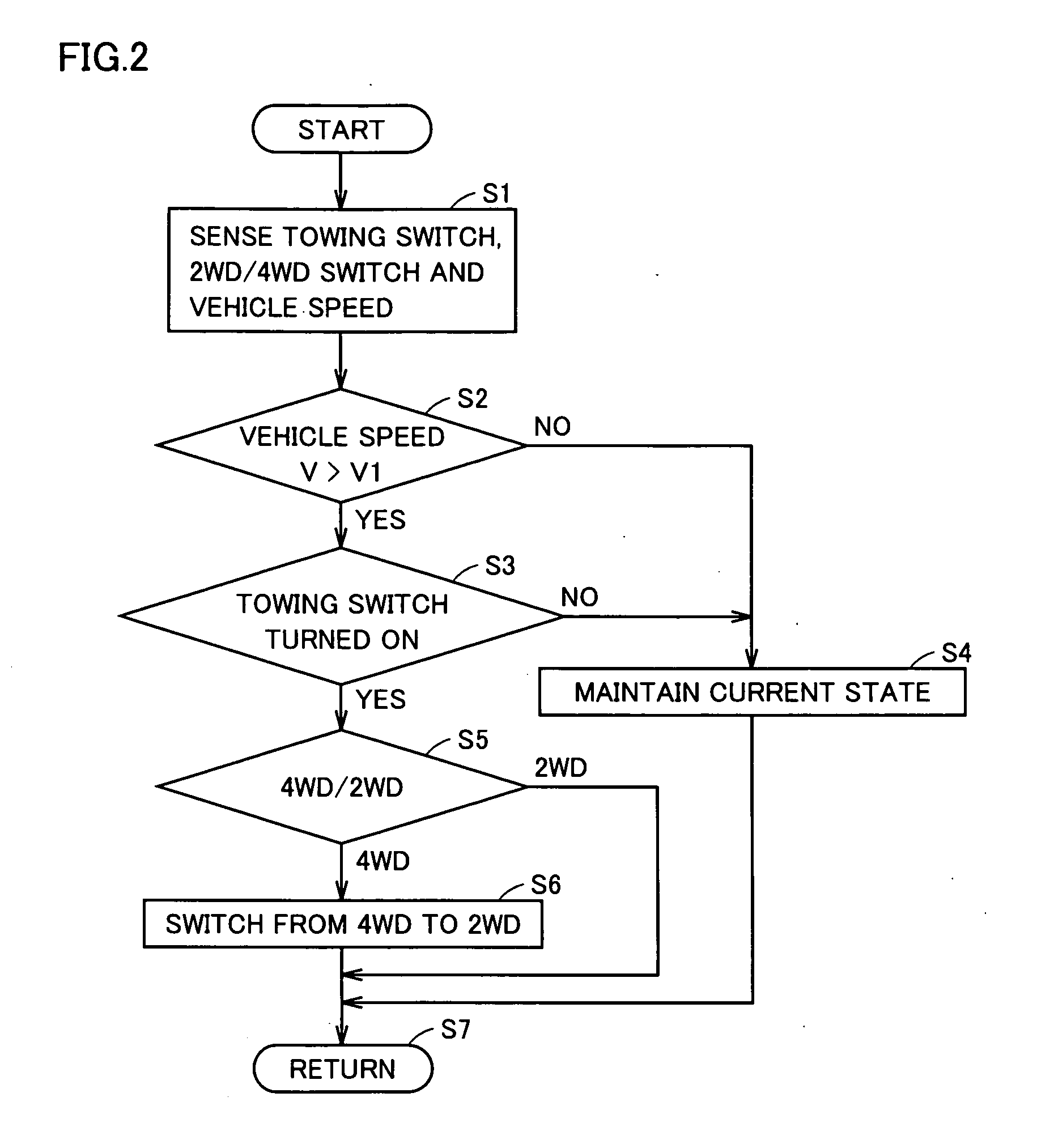Four-wheel drive vehicle running normally and with object towed thereby
a four-wheel drive, normal technology, applied in the direction of brake systems, process and machine control, instruments, etc., can solve the problems of affecting the durability of differentials, changing the diameter of front and rear wheels, and increasing the size of peripheral parts of driving wheels, so as to avoid an increase in the size of peripheral parts
- Summary
- Abstract
- Description
- Claims
- Application Information
AI Technical Summary
Benefits of technology
Problems solved by technology
Method used
Image
Examples
first embodiment
[0030]FIG. 1 is a block diagram showing a configuration of a vehicle 1 according to an embodiment of the present invention.
[0031] Referring to FIG. 1, vehicle 1 includes front wheels 2L, 2R, rear wheels 4L, 4R, an engine 6, a transmission 8 and a transfer 10.
[0032] Transfer 10 is a part for getting a torque which is transmitted from a powertrain in a base driving mode (a rear wheel drive in FIG. 1) to the wheels which are not originally driving wheels. Vehicle 1 further includes a transfer actuator 12, a front propeller shaft 14, a front differential 16 and front drive shafts 18, 20.
[0033] Vehicle 1 further includes a rear propeller shaft 22, a rear differential 24 and rear drive shafts 26, 28.
[0034] Transfer 10 has a center differential incorporated therein. Transfer actuator 12 is, for example, an electric motor. In response to the rotation of the motor, a shift fork moves to cause a movement of a sleeve got caught in the shift fork and thereby to switch back and forth between...
second embodiment
[0053]FIG. 3 is a flowchart showing a control structure of a program of transfer actuator ECU 30 carried out by a second embodiment.
[0054] Referring to FIGS. 1 and 3, first in step S11, a transfer actuator ECU 30 senses a gradient θ, an acceleration α, a setting of a 2WD / 4WD switch 42, a vehicle speed V, an engine speed NE and an accelerator pedal position ACC. In step S12, transfer actuator ECU 30 then determines whether vehicle speed V is greater than a predetermined value V1 or not.
[0055] If vehicle speed V is greater than V1, the process proceeds to step S13, and if not, the process proceeds to step S15.
[0056] In step S13, transfer actuator ECU 30 determines whether gradient θ of the vehicle sensed by a gradient sensor 38 is greater than a predetermined value θ1 or not.
[0057] In transfer actuator ECU 30, a table or map representing a relationship between an engine throttle angle and a vehicle speed (and a driving acceleration), and a gradient of the road surface on which the...
third embodiment
[0072]FIG. 5 is a flowchart showing a control structure of a program of a transfer actuator ECU 30 carried out in a third embodiment.
[0073] Referring to FIGS. 1 and 5, first in step S21, transfer actuator ECU 30 senses air pressures in a front wheel and a rear wheel, an acceleration α, a setting of a 2WD / 4WD switch 42, a vehicle speed V, an engine speed NE, and an accelerator pedal position ACC. In step S22, transfer actuator ECU 30 then determines whether vehicle speed V is greater than a predetermined value V1 or not.
[0074] If vehicle speed V is greater than V1, the process proceeds to step S23, and if not, the process proceeds to step S25.
[0075] In step S23, transfer actuator ECU 30 determines whether or not the air pressure in the rear wheel is greater than the air pressure in the front wheel. As shown in FIG. 6, the air pressure in the rear wheel is greater than the air pressure in the front wheel in towing an object. This suggests that the vehicle is in the towing state.
[0...
PUM
 Login to View More
Login to View More Abstract
Description
Claims
Application Information
 Login to View More
Login to View More - R&D
- Intellectual Property
- Life Sciences
- Materials
- Tech Scout
- Unparalleled Data Quality
- Higher Quality Content
- 60% Fewer Hallucinations
Browse by: Latest US Patents, China's latest patents, Technical Efficacy Thesaurus, Application Domain, Technology Topic, Popular Technical Reports.
© 2025 PatSnap. All rights reserved.Legal|Privacy policy|Modern Slavery Act Transparency Statement|Sitemap|About US| Contact US: help@patsnap.com



